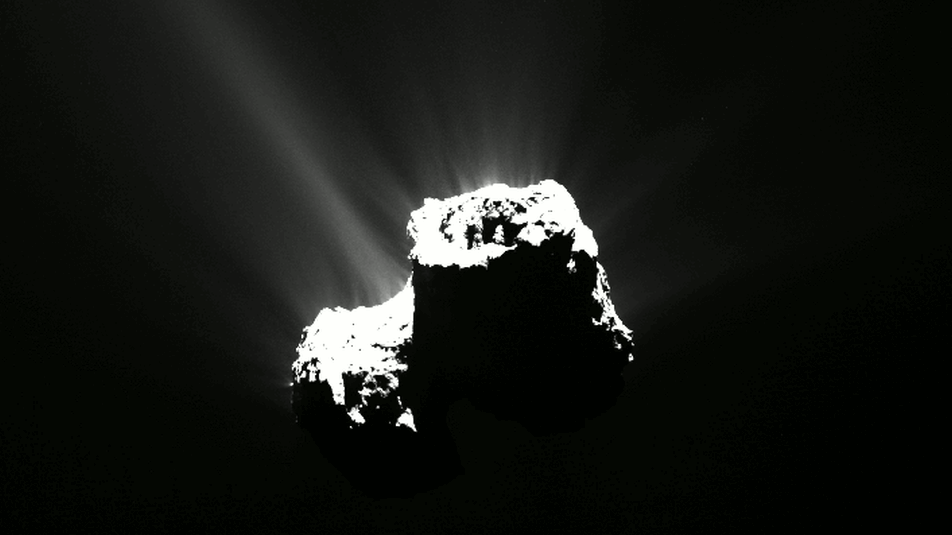Rosetta's 'rubber ducky' comet has ultraviolet auroras

Planets aren't the only things in the solar system with auroras. Comets can have them too, data from the European Space Agency's (ESA) Rosetta mission has revealed.
While looking at data from Rosetta, researchers found evidence of ultraviolet auroras at Comet 67P/Churyumov-Gerasimenko, which the probe studied up close for nearly two years before the mission ended in 2016.
"Rosetta is the first mission to observe an ultraviolet aurora at a comet," Matt Taylor, a Rosetta project scientist at ESA, said in a statement. "Auroras are inherently exciting — and this excitement is even greater when we see one somewhere new, or with new characteristics."
Related: Auroras over Earth: amazing Northern Lights photos from space
Similar to Earth's auroras (also called the Northern and Southern Lights), Comet 67P's auroras appear when charged particles from the sun, known as the solar wind, interact with atoms and molecules of gas around the comet, causing them to glow.
However, the auroras on Comet 67P are not as pretty as auroras on Earth — because they're invisible to the human eye. Earth's auroras, which appear when solar wind interacts with atmospheric particles like oxygen and nitrogen, boast vibrant shades of green, pink, purple and blue. But when solar wind strikes particles in the comet's coma — the cloud of gas flowing out from a comet's icy nucleus sometimes referred to as its "atmosphere" — it produces high-energy ultraviolet radiation, which is outside the range of visible light.
"The resulting glow is one of a kind," Marina Galand, an atmospheric physicist at Imperial College London and lead author of the study, said in the statement. "It's caused by a mix of processes, some seen at Jupiter's moons Ganymede and Europa and others at Earth and Mars."
Get the Space.com Newsletter
Breaking space news, the latest updates on rocket launches, skywatching events and more!
Related: What's it like to see auroras on other planets?
The researchers found that this high-energy radiation coming from Comet 67P's coma is the result of electrons in the solar wind being accelerated as they approach the comet, causing them to collide with its atmosphere, which consists of hydrogen, oxygen, nitrogen and other particles.
"Since this process is very high energy, the resulting glow is also highly energized and therefore in the ultraviolet range," Martin Rubin, a co-author of the study from the University of Bern Physics Institute, said in the statement.
Scientists had previously noticed ultraviolet emissions at Comet 67P, but they mistook these emissions to be photons, or particles of light emitted by the sun, interacting with the coma. "By analyzing the Rosetta data," Galand said, "it was revealed that solar wind electrons are the reason for the glow and not in fact photons, as previously assumed."
While Earth's auroras are driven by the planet's magnetic field, Comet 67P does not have a magnetic field. Earth's magnetic field funnels solar particles toward the planet's poles (hence the terms "Northern Lights" and "Southern Lights"), while Comet 67P's auroras are more spread out around the comet.
"The observation of cometary aurora phenomena definitely has an aesthetic value. Beyond that the UV observations from Earth could one day also provide information about the solar wind at these comets — even without a space probe like Rosetta being on site," Rubin said.
Galand and her colleagues used data from several different instruments to make this discovery, including the Rosetta Orbiter Spectrometer for Ion and Neutral Gas Analysis (ROSINA), Alice UV spectrograph, Ion and Electron Spectrometer, Langmuir Probe, Microwave Instrument for the Rosetta Orbiter (MIRO) and the Visible and Infrared Thermal Imaging Spectrometer (VIRTIS).
The team's findings were published Sept. 21 in the journal Nature Astronomy.
Email Hanneke Weitering at hweitering@space.com or follow her on Twitter @hannekescience. Follow us on Twitter @Spacedotcom and on Facebook.
Join our Space Forums to keep talking space on the latest missions, night sky and more! And if you have a news tip, correction or comment, let us know at: community@space.com.

Hanneke Weitering is a multimedia journalist in the Pacific Northwest reporting on the future of aviation at FutureFlight.aero and Aviation International News and was previously the Editor for Spaceflight and Astronomy news here at Space.com. As an editor with over 10 years of experience in science journalism she has previously written for Scholastic Classroom Magazines, MedPage Today and The Joint Institute for Computational Sciences at Oak Ridge National Laboratory. After studying physics at the University of Tennessee in her hometown of Knoxville, she earned her graduate degree in Science, Health and Environmental Reporting (SHERP) from New York University. Hanneke joined the Space.com team in 2016 as a staff writer and producer, covering topics including spaceflight and astronomy. She currently lives in Seattle, home of the Space Needle, with her cat and two snakes. In her spare time, Hanneke enjoys exploring the Rocky Mountains, basking in nature and looking for dark skies to gaze at the cosmos.









